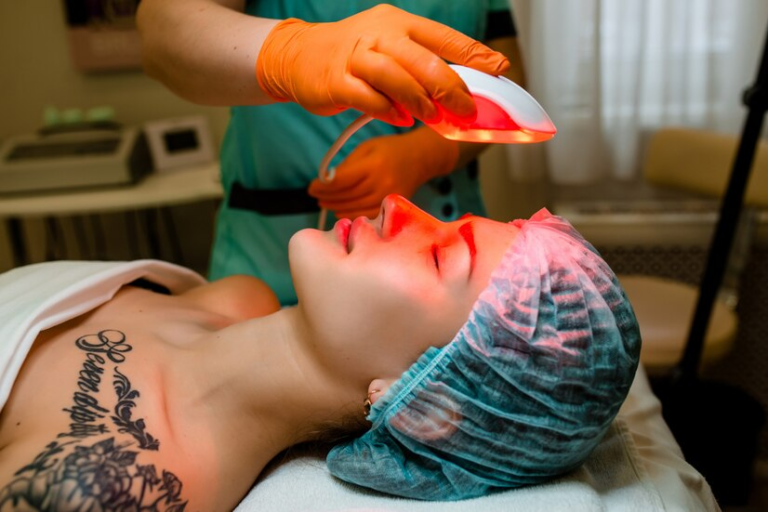I am wondering if it is possible to make red light therapy at home.
The good news is, yes, you definitely can.
However, it lacks advanced features, safety precautions, and proper treatment functions.
So, if you don’t get any of these features from your RLT, then there’s no point in making one. This is why it’s best if you buy red light therapy device from authentic providers!
Can You Make Red Light Therapy at Home?
Red light therapy has tens of benefits for skin health, muscle recovery, and pain relief. However, if you plan to get the most out of your RLT devices, DIY will not help.
DIY red light therapy is linked with multiple limitations and safety risks that require attention.
Understand You Will Have Several Limitations
Professional RLT devices have specific wavelengths; usually, for red lights, such wavelength ranges from 630nm to 660.
Near-infra-red light oscillates between 810 and 850nm, both critical for the effect.
As commercial LEDs are available, the DIY devices may not have the correct characteristics. This is also one of the reasons for the DIY setups to have unequal exposure.
Chances of Eye Damage, Skin Burns, and Overheating
If proper filtration is absent, it could potentially cause severe eye injury. Professional equipment includes safety features like protective eyewear and diffusers.
Plus, DIY devices are not properly constructed and this can lead to excessive heating. This can result in skin burns and overheating in the treated area.
However, this heating problem is not present with professional-grade devices, which have an internal cooling system.
Incorrect Exposure Time and Intensity
The dosage is a crucial safety and efficacy consideration! DIY RLT does not allow you to adjust any of these factors while administering the treatment.
Underdosing makes it ineffective while overdosing causes tissue damage and other conditions.
You Cannot Possibly Replicate Professional Devices
Complex Engineering and Calibration
Unlike DIY devices, RLT devices sent to the market are engineered to ensure that the right wavelength, intensity, and dosage reaches the skin.
Unless someone has the relevant education and access to corresponding testing equipment, it would be challenging to ensure the precision of the setup at home.
Quality Assurance and Safety Standards
Commercial equipment is subject to quality assurance processes.
Before the device can be sold to consumers, it needs to be correctly tested and meet all necessary safety requirements.
DIY devices do not have these assurances, making them unreliable and unsafe.
Quality of Components
Some professional devices have higher-quality components. They can also be designed for medical or therapeutic use, which makes them more durable and precise.
DIY projects, on the other hand, use easily available parts whose quality and manufacturing standards are often unknown.
What Are The Alternatives to DIY Red Light Therapy?
Here are the alternatives that you can go for instead of DIY red light therapy.
- Panels: These flat, large, and square-shaped devices simultaneously address vast areas of the whole body. They are most suitable for overall wellness, muscle recovery, and skin health, offering broad and uniform light distribution.
- Masks: These devices are specifically meant for facial exposure, making them perfect for various skin concerns, such as acne, wrinkles, and pigmentation. Most commonly, they have an adjustable intensity level or time, making this treatment hassle-free.
- Handheld devices: They are considered the most flexible device type. Since they are portable, users can take them wherever they go.
They are perfect for targeting the light on specific areas of your body – be it joints, specific area pain, or skin damage. - Pads and wraps: Their level of flexibility makes these devices irreplaceable. You can wrap, pad, or cover various body parts in these devices, which are mostly suitable for muscular pain and recovery.
These devices are suitable for close skin contact, so they can easily be used on delicate areas of skin.
Regulated and Controlled Light Output
Most commercial devices are programmed to emit light at certain therapeutic wavelengths and intensities.
This controlled emission is achieved only after stringent testing after several stages of ensuring that the device complies with safety standards.
Moreover, built-in timers and alternative settings ensure that a user never receives an overdose or overexposure to RLT or NIT.
The light levels have to be adjusted according to the required dosages, and the safety sensors reduce the risk of overexposure.
RLT, for instance, should be done for 20-25 minutes maximum. Although it is not necessarily dangerous for the human skin and body, overexposure may lead to:
- Skin rashes
- Headaches
- Eye pain
- Tiredness
Professional Treatments
Professional spa and clinic appointments may work for those who can not maintain regular or regulated schedules or the treatments allow.
These are usually more intense and for serious conditions, as they involve the use of high-grade, specialized machines and equipment and qualified professionals to offer the treatment.
5 Things to Consider When Buying a Device
Here are the things you need to consider when buying your ideal red light therapy device for your home:
- Purchase based on the wavelength, ensuring it is therapeutically appropriate for red and NIR based on the ranges given above.
- Verify that the device dosage and treatment times can properly deliver to your health needs, including overexposure risks.
- Consider the manufacturer’s credibility and certification of the red light therapy device meeting the required safety and performance standards.
- Evaluate the economics by checking the upfront cost of the device and the long-term savings from professional treatments.
- Evaluate these factors to purchase a safe and effective device that optimally guards your investment.

